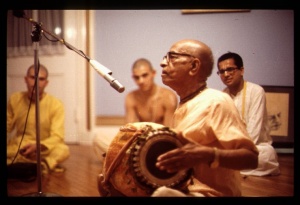CC Adi 10.48: Difference between revisions
m (1 revision(s)) |
No edit summary |
||
| Line 1: | Line 1: | ||
{{ | [[Category:Sri Caitanya-caritamrta - Adi-lila Chapter 10|C048]] | ||
<div style="float:left">'''[[Sri Caitanya-caritamrta|Śrī Caitanya-caritāmṛta]] - [[CC Adi|Ādi-līlā]] - [[CC Adi 10|Chapter 10: The Trunk, Branches and Subbranches of the Caitanya Tree]]'''</div> | |||
<div style="float:right">[[File:Go-previous.png|link=CC Adi 10.47|Ādi-līlā 10.47]] '''[[CC Adi 10.47|Ādi-līlā 10.47]] - [[CC Adi 10.49|Ādi-līlā 10.49]]''' [[File:Go-next.png|link=CC Adi 10.49|Ādi-līlā 10.49]]</div> | |||
{{CompareVersions|CC|Adi 10.48|CC 1975|CC 1996}} | |||
{{RandomImage}} | |||
==== TEXT 48 ==== | ==== TEXT 48 ==== | ||
<div | <div class="verse"> | ||
tāṅra upaśākhā—yata kulīna-grāmī jana | :tāṅra upaśākhā—yata kulīna-grāmī jana | ||
satyarāja-ādi—tāṅra kṛpāra bhājana | :satyarāja-ādi—tāṅra kṛpāra bhājana | ||
</div> | </div> | ||
| Line 12: | Line 16: | ||
==== SYNONYMS ==== | ==== SYNONYMS ==== | ||
<div | <div class="synonyms"> | ||
tāṅra | ''tāṅra upaśākhā''—his subbranch; ''yata''—all; ''kulīna-grāmī jana''—the inhabitants of Kulīna-grāma; ''satyarāja''—Satyarāja; ''ādi''—heading the list; ''tāṅra''—his; ''kṛpāra—''of mercy; ''bhājana—recipient. | ||
</div> | </div> | ||
| Line 19: | Line 23: | ||
==== TRANSLATION ==== | ==== TRANSLATION ==== | ||
<div | <div class="translation"> | ||
One subbranch of Haridāsa Ṭhākura consisted of the residents of Kulīna-grāma. The most important among them was Satyarāja Khān, or Satyarāja Vasu, who was a recipient of all the mercy of Haridāsa Ṭhākura. | One subbranch of Haridāsa Ṭhākura consisted of the residents of Kulīna-grāma. The most important among them was Satyarāja Khān, or Satyarāja Vasu, who was a recipient of all the mercy of Haridāsa Ṭhākura. | ||
</div> | </div> | ||
| Line 26: | Line 30: | ||
==== PURPORT ==== | ==== PURPORT ==== | ||
<div | <div class="purport"> | ||
Satyarāja Khān was the son of Guṇarāja Khān and father of Rāmānanda Vasu. Haridāsa Ṭhākura lived for some time during the Cāturmāsya period in the village named Kulīna-grāma, where he chanted the holy name, the Hare Kṛṣṇa mahā-mantra, and distributed his mercy to the descendants of the Vasu family. Satyarāja Khān was allotted the service of supplying silk ropes for the Jagannātha Deity during the Ratha-yātrā festival. Śrī Caitanya Mahāprabhu’s answers to his inquiries about the duty of householder devotees are vividly described in the Madhya-līlā, Chapters Fifteen and Sixteen. | Satyarāja Khān was the son of Guṇarāja Khān and father of Rāmānanda Vasu. Haridāsa Ṭhākura lived for some time during the Cāturmāsya period in the village named Kulīna-grāma, where he chanted the holy name, the Hare Kṛṣṇa ''mahā-mantra'', and distributed his mercy to the descendants of the Vasu family. Satyarāja Khān was allotted the service of supplying silk ropes for the Jagannātha Deity during the Ratha-yātrā festival. Śrī Caitanya Mahāprabhu’s answers to his inquiries about the duty of householder devotees are vividly described in the ''Madhya-līlā'', Chapters Fifteen and Sixteen. | ||
The village of Kulīna-grāma is situated two miles from the railway station named Jaugrāma on the Newcord line from Howrah to Burdwan. Lord Caitanya Mahāprabhu very highly praised the people of Kulīna-grāma, and He stated that even a dog of Kulīna-grāma was very dear to Him. | The village of Kulīna-grāma is situated two miles from the railway station named Jaugrāma on the Newcord line from Howrah to Burdwan. Lord Caitanya Mahāprabhu very highly praised the people of Kulīna-grāma, and He stated that even a dog of Kulīna-grāma was very dear to Him. | ||
</div> | </div> | ||
__NOTOC__ | |||
<div style="float:right; clear:both;">[[File:Go-previous.png|link=CC Adi 10.47|Ādi-līlā 10.47]] '''[[CC Adi 10.47|Ādi-līlā 10.47]] - [[CC Adi 10.49|Ādi-līlā 10.49]]''' [[File:Go-next.png|link=CC Adi 10.49|Ādi-līlā 10.49]]</div> | |||
__NOTOC__ | |||
__NOEDITSECTION__ | |||
Revision as of 06:14, 21 July 2021

A.C. Bhaktivedanta Swami Prabhupada
TEXT 48
- tāṅra upaśākhā—yata kulīna-grāmī jana
- satyarāja-ādi—tāṅra kṛpāra bhājana
SYNONYMS
tāṅra upaśākhā—his subbranch; yata—all; kulīna-grāmī jana—the inhabitants of Kulīna-grāma; satyarāja—Satyarāja; ādi—heading the list; tāṅra—his; kṛpāra—of mercy; bhājana—recipient.
TRANSLATION
One subbranch of Haridāsa Ṭhākura consisted of the residents of Kulīna-grāma. The most important among them was Satyarāja Khān, or Satyarāja Vasu, who was a recipient of all the mercy of Haridāsa Ṭhākura.
PURPORT
Satyarāja Khān was the son of Guṇarāja Khān and father of Rāmānanda Vasu. Haridāsa Ṭhākura lived for some time during the Cāturmāsya period in the village named Kulīna-grāma, where he chanted the holy name, the Hare Kṛṣṇa mahā-mantra, and distributed his mercy to the descendants of the Vasu family. Satyarāja Khān was allotted the service of supplying silk ropes for the Jagannātha Deity during the Ratha-yātrā festival. Śrī Caitanya Mahāprabhu’s answers to his inquiries about the duty of householder devotees are vividly described in the Madhya-līlā, Chapters Fifteen and Sixteen.
The village of Kulīna-grāma is situated two miles from the railway station named Jaugrāma on the Newcord line from Howrah to Burdwan. Lord Caitanya Mahāprabhu very highly praised the people of Kulīna-grāma, and He stated that even a dog of Kulīna-grāma was very dear to Him.